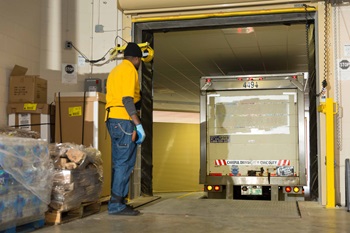By: Marjorie DePuy, Senior Director, Supply Chain and Sustainability, Food Marketing Institute

At June’s TPA Transportation Summit, Federal Motor Carrier Safety Administration (FMCSA) Administrator Raymond Martinez acknowledged that our audience of logistics and transportation experts “fuel and feed the economy.” Administrator Martinez charged the group to consider, “How can data and technology drive the industry forward?”
Over the course of the two-day event, industry partners came together to learn and share emerging practices, particularly around detention (dwell) time. We heard real-world examples of data-driven decision making and technology that is addressing dwell time at the distribution center. Kellogg’s shared that they have moved from the bottom to near the top of the list as a shipper of choice by evaluating their network for optimization opportunities in operations, technology and paperwork and reducing their turn times for drop trailers and live loads.
Supply chain leaders from Coca-Cola, Giant-Eagle and Land O’Lakes shared highlights from their recent TPA pilot activity to understand and reduce dwell time at select facilities. Aided by advisors at McKinsey & Company and Four Kites, the team (including Wegman’s and their carrier partners) evaluated data from select warehouses on a weekly basis for six months, meeting to brainstorm for solutions and ideas. They looked at physical attributes in the yard, technology for drivers and warehouse staff, manpower utilization and shift alignment with scheduled loads and broader topics like culture shifts in management.
The result of the pilot project and collaboration is the realization of the potential to create two to four percent additional capacity by improving the dwell time within their control. Don’t let the ‘small’ number fool you. This has big potential.
Effective transportation management founded in collaboration is key to a healthy supply chain in food retail. I’d add now, in an era of urgent focus on reducing carbon footprints, that we need to look within our four walls, in our shipping lanes, and across our supply chains for opportunities to collaborate, improve, remove empty miles and reduce wasted waiting time all along the road from farm to fork.


 Industry Topics address your specific area of expertise with resources, reports, events and more.
Industry Topics address your specific area of expertise with resources, reports, events and more.
 Our Research covers consumer behavior and retail operation benchmarks so you can make informed business decisions.
Our Research covers consumer behavior and retail operation benchmarks so you can make informed business decisions.
 Events and Education including online and in-person help you advance your food retail career.
Events and Education including online and in-person help you advance your food retail career.
 Food Safety training, resources and guidance that help you create a company food safety culture.
Food Safety training, resources and guidance that help you create a company food safety culture.
 Government Affairs work — federal and state — on the latest food industry policy, regulatory and legislative issues.
Government Affairs work — federal and state — on the latest food industry policy, regulatory and legislative issues.
 Get Involved. From industry awards to newsletters and committees, these resources help you take advantage of your membership.
Get Involved. From industry awards to newsletters and committees, these resources help you take advantage of your membership.
 Best practices, guidance documents, infographics, signage and more for the food industry on the COVID-19 pandemic.
Best practices, guidance documents, infographics, signage and more for the food industry on the COVID-19 pandemic.
